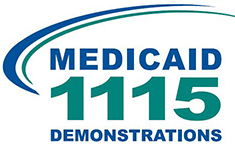 Federal law authorizes experimentation by state Medicaid programs through section 1115 of the Social Security Act. Section 1115 allows states to implement and test new approaches to administering Medicaid programs that depart from existing federal rules yet stay consistent with the overall goals of the program. Mathematica's evaluation of Medicaid section 1115 demonstrations, approximately 40 in number, seeks to assess the implementation and outcomes of four different types of innovations and help CMCS shift toward data-driven decision making for future waiver approvals.
Federal law authorizes experimentation by state Medicaid programs through section 1115 of the Social Security Act. Section 1115 allows states to implement and test new approaches to administering Medicaid programs that depart from existing federal rules yet stay consistent with the overall goals of the program. Mathematica's evaluation of Medicaid section 1115 demonstrations, approximately 40 in number, seeks to assess the implementation and outcomes of four different types of innovations and help CMCS shift toward data-driven decision making for future waiver approvals.
 Federal law authorizes experimentation by state Medicaid programs through section 1115 of the Social Security Act. Section 1115 allows states to implement and test new approaches to administering Medicaid programs that depart from existing federal rules yet stay consistent with the overall goals of the program. Mathematica's evaluation of Medicaid section 1115 demonstrations, approximately 40 in number, seeks to assess the implementation and outcomes of four different types of innovations and help CMCS shift toward data-driven decision making for future waiver approvals.
Federal law authorizes experimentation by state Medicaid programs through section 1115 of the Social Security Act. Section 1115 allows states to implement and test new approaches to administering Medicaid programs that depart from existing federal rules yet stay consistent with the overall goals of the program. Mathematica's evaluation of Medicaid section 1115 demonstrations, approximately 40 in number, seeks to assess the implementation and outcomes of four different types of innovations and help CMCS shift toward data-driven decision making for future waiver approvals.
Recent demonstrations can be categorized according to whether they focus on delivery system reforms (Type 1), alternative ways to provide coverage to newly eligible adults (Types 2 and 3), or expansions of managed care to serve people who are frail or disabled (Type 4).
Type 1 states are implementing Delivery System Reform Incentive Payment (DSRIP) programs to reward providers for quality improvements. DSRIP is a federal pay-for-performance initiative financed by redirecting supplemental payments that have traditionally been available only to hospitals for the provision of uncompensated care. DSRIP enables states to use Medicaid funds to reward providers for successfully implementing projects that improve patient care, improve health outcomes, and reduce costs.
Type 2 states are using mandatory premium assistance as a method of providing coverage to adult Medicaid populations newly eligible under the Affordable Care Act. These states use Medicaid funds to enroll adults in qualified health plans in insurance marketplaces.
Type 3 states are testing alternative ways of providing adult coverage by using incentives to encourage personal responsibility and healthy behaviors. Several of the demonstrations have introduced premiums that begin at lower income levels than have previously been permitted. Beneficiaries can reduce their payment requirements by adopting certain healthy behaviors.
Type 4 states are using section 1115 demonstration authority to provide long-term services and supports through managed care programs (referred to as MLTSS arrangements).This group includes states that are consolidating operating requirements of MLTSS programs that were authorized through other vehicles, states that are expanding MLTSS programs to new populations and regions, and states that are replacing former pilot programs with larger, more permanent groups.
Implementation analyses are reported each year in rapid cycle reports while outcome analyses will be conducted twice. All analyses and reporting will be conducted separately by demonstration type and will rely primarily on secondary data sources. Finalized reports are available on Medicaid.gov.
In addition to the formal evaluation work, this project includes several types of technical assistance to CMCS:
- Review of state-led evaluation products for section 1115 demonstrations – including evaluation designs and reports – and recommendations to CMCS on how those products can be strengthened. To date, we have advised on evaluation products from more than 15 states and developed technical assistance guides to aid states in selecting appropriate comparison groups for evaluations and making causal inferences about the effects of demonstration policies.
- Project management and technical support to CMS in standing up new demonstrations that address substance use disorders (SUD) and require community engagement (CE) as a condition of eligibility. Project staff are developing monitoring tools and trainings to facilitate state reporting and CMS oversight of SUD and CE demonstrations and will track implementation progress across states with these demonstrations.
- Managing internal and external stakeholder input to help develop content for the Medicaid and CHIP Scorecard, a major new initiative to enhance public transparency about the programs’ administration and outcomes. The first Scorecard was released in June 2018.
- Analyses of the uncompensated care pools that operate under section 1115 authority. To date, Mathematica has assessed uncompensated care pool evaluation reports or provided uncompensated care analyses for six states, produced a cross-state synthesis of uncompensated care pools, and prepared a review of alternative payment methodologies used by state Medicaid programs.
- Development of monitoring metrics for different demonstration types. To support more consistent monitoring of section 1115 demonstrations with common policy objectives or strategies, the project is supporting the selection and specification of priority monitoring metrics.
- Support on topics in quality measurement that are routinely encountered as part of Medicaid innovation efforts, such as selecting appropriate quality measures, establishing quality measure benchmarks and thresholds, and linking data sources to support accurate measurement.
 Federal law authorizes experimentation by state Medicaid programs through section 1115 of the Social Security Act. Section 1115 allows states to implement and test new approaches to administering Medicaid programs that depart from existing federal rules yet stay consistent with the overall goals of the program. Mathematica's evaluation of Medicaid section 1115 demonstrations, approximately 40 in number, seeks to assess the implementation and outcomes of four different types of innovations and help CMCS shift toward data-driven decision making for future waiver approvals.
Federal law authorizes experimentation by state Medicaid programs through section 1115 of the Social Security Act. Section 1115 allows states to implement and test new approaches to administering Medicaid programs that depart from existing federal rules yet stay consistent with the overall goals of the program. Mathematica's evaluation of Medicaid section 1115 demonstrations, approximately 40 in number, seeks to assess the implementation and outcomes of four different types of innovations and help CMCS shift toward data-driven decision making for future waiver approvals.





